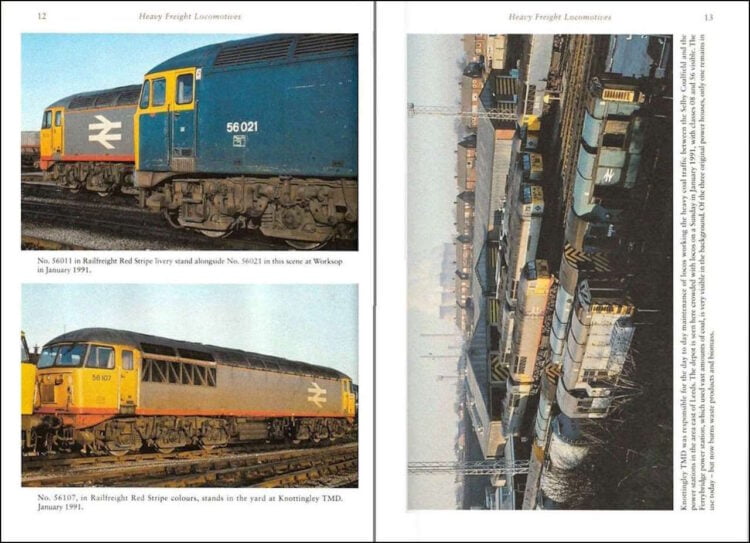This book is a selection of the author's photographs taken between the 1970s and 2019 of the more-powerful diesel locomotives that hauled heavy freight trains around the UK.
Published in November 2022 by Amberley Publishing and written by George Woods, this soft cover book measures around 23.4 cm x 16.5 cm, and has 96 pages and 180 illustrations. It has a published price of £15.99, but at the time of writing it can be purchased for £14.39 from Amberley Publishing and for £11.85 from Amazon.
A three-page introduction describing the evolution of the present-day range of diesel locomotives is followed by groups of pages illustrating classes 56, 57, 58, 59, 60, 66, and 70 in sequence. Ideally, it would have been preferable to have Section breaks for each class.
The inclusion of the Class 57s seems surprising as there are no photographs of the far-more numerous Class 47s from which they were developed. Also, of the ten photos in the Class 57 section, only one is of the Class 57/0 freight variant, while the rest are of the class 57/3 and 57/6 variants which were intended for passenger use, which seems at odds with the book's title.
I must take issue with the author's statement that it was the effectiveness of the Class 59 that caused other rail freight operators to follow suit and order what became the Class 66. The Class 66 came about after Ed. Burkhardt, the owner of Wisconsin Central Transportation System, bought most of Britain's newly-privatised freight companies and created English Welsh & Scottish Railway (EWS) and placed an order for 250 units.
The photographic reproduction is generally good, but strangely although the majority of the book has two photos per pages, some have three whilst others just a single photo that is annoyingly printed sideways.
The author seems to have a number of favourite locations particularly at Gascoigne Wood, as they account for a large proportion of the content, often with identical locos in the same livery.
Now just a memory are scenes such as the one on the right below of Knottingley shed full of locos awaiting their turn of duty and undergoing maintenance. This is one of the photes in the book that has annoyingly been printed sideways.

The pages below mark the end of the Class 56 illustrations sequence and the start of the Class 57s, but other than looking at the locomotive numbers there is nothing to indicate the start of the new section. Although the book is titled Heavy Freight locomotives, the Class 57 at the top right is the only Class 57/0 freight variant included, as the rest of this section are Class 57/6s that are nominally for passenger use.
Although photographs from a wide range of locations have been included, the impression is that the author has a number of favourites such as Gascoigne Wood on the right below.
Reinforcing the comment about Gascoigne Wood being a favourite location of the author is the bottom-right photo below. Similarly, with the other photos on these pages, especially the left-hand page which shows two virtually identical shots from the same location.
One of the features that enlivens today's railway scene is the range of different liveries. This can be seen on the left below where GB Railfreight's large logo on the side of the upper loco has been replaced with a Union Jack in the lower one, which also has the loco's name Golden Jubilee added on a plate above the number.
The three-page Introduction provides a useful background to why the later classes of heavy freight locomotives were brought into use. Although the book groups photographs of each class together, it would have been useful to have a Section title before the commencement of the next class, and section titles included in the book's headers rather than having the book title repeated on each page.
The captions are well written and include extra information about the photographs over and above the usual what, where, and when details.
A major omission is the Class 47s, even though the Class 57 variants have been included. However, these are mostly of the class 57/3 and 57/6 variants, which were developed for passenger use and are at odds with the book's title.
Although the photographic reproduction is generally good with two photos per pages, it seems an odd decision to reproduce some as three photos per page yet include others as a single photo, annoyingly printed sideways.
Whilst there are a wide range of locations, they are nearly all in the north of England. Also. a number of photographs are taken from the same locations often showing locos in identical liveries.
The book is available to purchase from Amazon and from Amberley Publishing.
We would like to thank Amberley Publishing for providing us with a copy of the book for review.